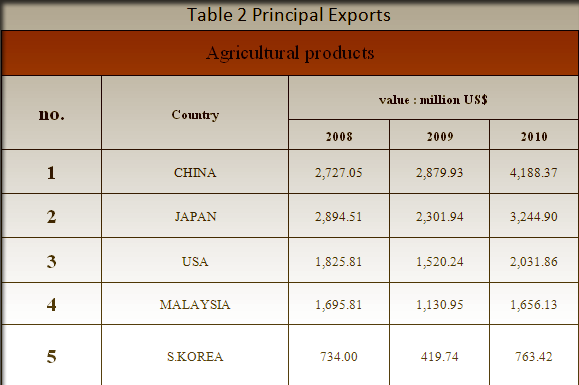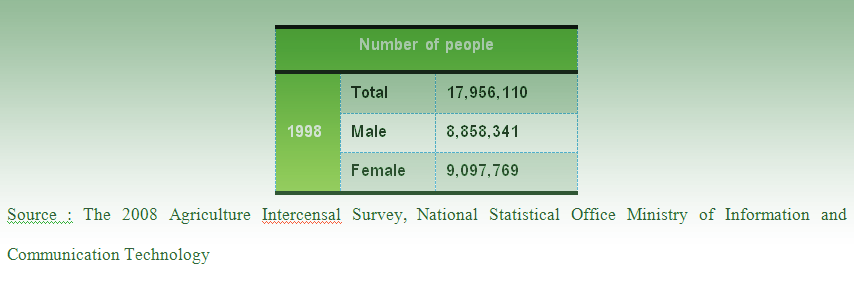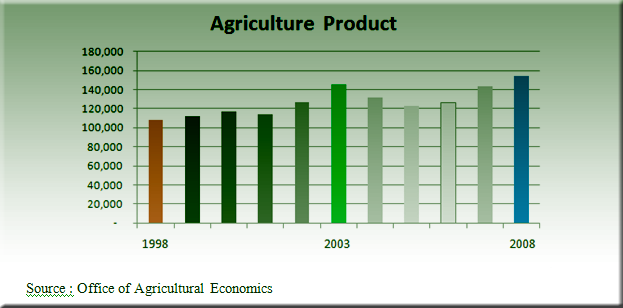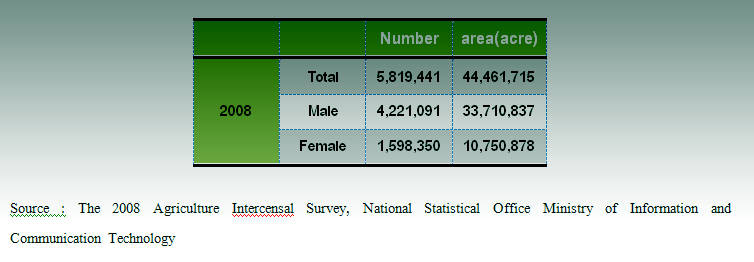Female Workers in the Agricultural Sector
 This article was written by Group 9 in , as part of the .
This article was written by Group 9 in , as part of the .
Table of Contents
Introduction
Agriculture has been the main area of work of Thai people for a long time.ODI website,(2010). Thailand’s progress in agriculture: Managing transition and sustaining productivity growthRetrieved 23 July 2012 Some of the agricultural products include rubber, rice, tapioca products, etc. The table 1 below shows the top 5 of the main exports from Thailand to other countries in the years 2008-2010:
Thailand has many resources for the production of agricultural products. Due to the demand of other countries, Thailand can export agricultural products, which creates economic growth. Table 2 below shows the top 5 of countries that import agricultural products from Thailand in the years 2008-2010:
Today, the agricultural sector plays a diminished role in the Thai economy due to trade liberalisationCentre of Alleviation of Poverty throught Sustainable Agriculture(CAPSA) By UN, (5 October 1999).Trade liberalization Retrieved 23 July 2012 and the introduction of new technology. This has led to a greater role of the industrial sector.
Land owners
Land owners in 1998
In 1998, Land owners comprised approximately 18 million people. National Statistical Office Thailand,(2003) Land ownersRetrieved 25 July 2012 Subsequently, the rate of land owners declined because of the financial and economic crisis in 1997 and the labour mobility from the agriculture sector to the industrial sector.Rural Labour Mobility and its Impact on Agricultural Land Use Review, Labour mobilityRetrieved 23 July 2012
2003: Less land owners but more products
In 2003, there were approximately 1.6 million female land owners in Thailand using 10.7 million acre. Of these, 10 million acre was used for agriculture purposes by 1.44 million women. This shows that Thai women have a predominant role in the agricultural sector. However in 1998 the total share of land owners was higher than in 2003 because of the 1997 economic crisis in Thailand,International Monetary Fund,(June 1998)The Asian CrisisRetrieved 25 August 2012 which made the price of agricultural products drop. This led to a higher burden of debt, which means that landowners had to sell their property, including land property to pay the debt. The crisis made the number of land owners decrease but did not affect the quantity of products.
The agricultural yield increased by 34% from 1998 until 2003, despite the reduced size of the land, due to advances in knowledge, technology and increased efficiency in production processes to compete with the international market. Also, the increasing use of organic fertilizers and genetic technology to make plants grow stronger contributed to the increase of the agricultural yield.
Thailand registers the number of land owners every 5 years, the last time was in 2008.
How Thailand supports agriculture
In 2008, the total share of land owners consisted of approximately 5.8 million people, for 44 million acres. The total rate of land owners increased by about 0.19% (since 2003). The share of female land owners decreased by 0.6%. 1.4 million women use 9.9 million acre for agriculture purposes, 0.85 million women use for other purposes. The percentage of female labour that use land for agriculture decreased by about 2.6%. The agricultural products in 2008 represented about 1500 tons, which increased from 2003 by about 6% as a result of Thailand’s support for the agriculture sector via the Thai National Economic and Social Development Plan. This 8th plan, (1997). Office of the National Economic and Social Development Board,Thai National Economic and Social Development PlanRetrieved 26 July 2012 in line with the sustainable economic development thinking and the royal thought base on the Sufficiency economy philosophy of His Majesty the KingNorth Education,(29 November 1999).The Sufficiency economy philosophy of His Majesty KingRetrieved 26 July 2012, aims to raise awareness of the Thai population of the importance of infrastructure in the country. Between the years 2007-2009, the industry of Thailand was affected by the Hamburger crisis of Subprime crisis.Thaiworld,(2008).Thailand and Hamburger crisisRetrieved 25 August 2012 Most of the labour force was laid off from the industry sector and had to move back to work in the agricultural sector, which was supported by the government.
Government Policy
At present the government has the policy of restructuring the economic system by focusing on how to get value-added in products based on culture, local knowledge and wisdom, and how to create new enterprises in Thailand, by restructuring the agricultural sector. The government will provide support in research, innovation and biotechnology, which will he coupled with the use of local knowledge.The Government Public Relations Department Thailand,(23 March 2012). Government policyRetrieved 26 July 2012 The government will also promote the role of women in agriculture by establishing the role of the development fund for women.The Government Public Relations Department Thailand,(12 February 2012).Thailand’s National Development Fund for WomenRetrieved 26 July 2012 The Fund will provide support in the form of a consulting organisation and also by providing training courses in agriculture, group activities, skills development and the promotion of savings. Today there are more agencies providing financial support for professional development, compared to the past when women in agriculture were informal workers and did not benefit from social protection or financial support.
Current trends in agricultural production
Agricultural production is increasing steadily. For example, renewable energy Department of Mineral Resources,Renewable energyRetrieved 12 August 2012, horticulture Department of Agriculture Extension, HorticultureRetrieved 12 August 2012 and livestock and fisheriesForeign Office
The Government Public Relations Department livestock and fisheriesRetrieved 12 August 2012 have all increased. However, some products have lower productivity. For example, sugar-cane suffers from droughtThai Sugar millers Corporation Limited, (24 March 2010)Suger-Cane suffers from droughtRetrieved 12 August 2012 and in 2011, Thailand suffered from an important flood crisis CSIS Asia policy Blog,(25 October 2011).Damaging of Big FloodRetrieved 12 August 2012, which led to low fruit productivity.
Land acquisition by a Thai national married to a foreigner
If a Thai woman marries a foreigner, she can own the land. In the past, Thai spouses of foreigners could not buy the land, but now they can.Thai legal and assosiation Land acquisition by a Thai national married to a foreigner Retrieved 12 August 2012.
If the land was bought during the marriage, when someone bought the land, it is considered private property, not marriage property. For example, if the one who buys the land is the woman, the land will belong to the woman.
References
Ministry Of Commerce. (2012). Trade Statistic. ,available at http://www2.ops3.moc.go.th/
See also
External links
Group 9
Group The members of ECS 485 Group 9 are:1. Mr. Jaruwat Amesbutra
2. Miss Budsara Udompramaun
3. Mr. Sumetha Viriyaaksornsakun
4. Miss Asama Sasitanakornkeaw
5. Miss Natchaya Yatepat
6. Miss Nannaphat Chantharawong
7. Miss Benjira Akeudomsub
- Wikigender University student article Thailand, School of Economics and Public Policy, Srinakharinwirot University.
[User:Jaruwat|Jaruwat] 19:38, 30 July 2012 (CEST)







